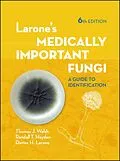The definitive guide for identifying fungi from clinical specimens
Medically Important Fungi will expand your knowledge and support your work by:
* Providing detailed descriptions of the major mycoses as viewed in patients' specimens by direct microscopic examination of stained slides
* Offering a logical step-by-step process for identification of cultured organisms, utilizing detailed descriptions, images, pointers on organisms' similarities and distinctions, and selected references for further information
* Covering nearly 150 of the fungi most commonly encountered in the clinical mycology laboratory
* Presenting details on each organism's pathogenicity, growth characteristics, relevant biochemical reactions, and microscopic morphology, illustrated with photomicrographs, Dr. Larone's unique and elegant drawings, and color photos of colony morphology and various test results
* Explaining the current changes in fungal taxonomy and nomenclature that are due to information acquired through molecular taxonomic studies of evolutionary fungal relationships
* Providing basic information on molecular diagnostic methods, e.g., PCR amplification, nucleic acid sequencing, MALDI-TOF mass spectrometry, and other commercial platforms
* Including an extensive section of easy-to-follow lab protocols, a comprehensive list of media and stain procedures, guidance on collection and preparation of patient specimens, and an illustrated glossary
With Larone's Medically Important Fungi: A Guide to Identification, both novices and experienced professionals in clinical microbiology laboratories can continue to confidently identify commonly encountered fungi.
If you are looking for online access to the latest clinical microbiology content, please visit www.wiley.com/learn/clinmicronow.
Autorentext
Davise H. Larone is well known as the originator of the book that many readers have come to rely upon for assistance in the accurate identification of fungi from patient specimens, a key step in treating mycotic infections. Dr. Larone has now been joined by Thomas J. Walsh and Randall T. Hayden to update this gold standard reference while retaining the format that has made this guide so popular for more than 40 years.
Klappentext
Larone's Medically Important Fungi
Sixth Edition
The definitive guide for identifying fungi from clinical specimens
Medically Important Fungi will expand your knowledge and support your work by:
- Providing detailed descriptions of the major mycoses as viewed in patients' specimens by direct microscopic examination of stained slides
- Offering a logical step-by-step process for identification of cultured organisms, utilizing detailed descriptions, images, pointers on organisms' similarities and distinctions, and selected references for further information
- Covering nearly 150 of the fungi most commonly encountered in the clinical mycology laboratory
- Presenting details on each organism's pathogenicity, growth characteristics, relevant biochemical reactions, and microscopic morphology, illustrated with photomicrographs, Dr. Larone's unique and elegant drawings, and color photos of colony morphology and various test results
- Explaining the current changes in fungal taxonomy and nomenclature that are due to information acquired through molecular taxonomic studies of evolutionary fungal relationships
- Providing basic information on molecular diagnostic methods, e.g., PCR amplification, nucleic acid sequencing, MALDI-TOF mass spectrometry, and other commercial platforms
- Including an extensive section of easy-to-follow lab protocols, a comprehensive list of media and stain procedures, guidance on collection and preparation of patient specimens, and an illustrated glossary
With Larone's Medically Important Fungi: A Guide to Identification, both novices and experienced professionals in clinical microbiology laboratories can continue to confidently identify commonly encountered fungi.
Zusammenfassung
The definitive guide for identifying fungi from clinical specimens
Medically Important Fungi will expand your knowledge and support your work by:
- Providing detailed descriptions of the major mycoses as viewed in patients' specimens by direct microscopic examination of stained slides
- Offering a logical step-by-step process for identification of cultured organisms, utilizing detailed descriptions, images, pointers on organisms' similarities and distinctions, and selected references for further information
- Covering nearly 150 of the fungi most commonly encountered in the clinical mycology laboratory
- Presenting details on each organism's pathogenicity, growth characteristics, relevant biochemical reactions, and microscopic morphology, illustrated with photomicrographs, Dr. Larone's unique and elegant drawings, and color photos of colony morphology and various test results
- Explaining the current changes in fungal taxonomy and nomenclature that are due to information acquired through molecular taxonomic studies of evolutionary fungal relationships
- Providing basic information on molecular diagnostic methods, e.g., PCR amplification, nucleic acid sequencing, MALDI-TOF mass spectrometry, and other commercial platforms
- Including an extensive section of easy-to-follow lab protocols, a comprehensive list of media and stain procedures, guidance on collection and preparation of patient specimens, and an illustrated glossary
With Larone's Medically Important Fungi: A Guide to Identification, both novices and experienced professionals in clinical microbiology laboratories can continue to confidently identify commonly encountered fungi.
Inhalt
List of Tables xv
Preface to the Fifth Edition xvii
Preface to the First Edition xix
Acknowledgments xxi
How to Use the Guide 1
Use of Reference Laboratories 3
Safety Precautions 7
Part I Direct Microscopic Examination of Clinical Specimens
Introduction 11
Histological Terminology 13
Tissue Reactions to Fungal Infection 17
Stains 21
Table 1 Stains for direct microscopic observation of fungi and/or filamentous bacteria in tissue 22
Guide to Interpretation of Direct Microscopic Examination 23
Detailed Descriptions 31
Actinomycosis 33
Mycetoma, Actinomycotic or Eumycotic 34
Nocardiosis 36
Zygomycosis 37
Aspergillosis 38
Miscellaneous Hyalohyphomycoses 40
Dermatophytosis 42
Tinea versicolor 43
Tinea nigra 44
Phaeohyphomycosis 45
Chromoblastomycosis 46
Sporotrichosis 47
Histoplasmosis capsulati 48
Penicilliosis marneffei 50
Blastomycosis 52
Paracoccidioidomycosis 53
Candidiasis (Candidosis) 54
Trichosporonosis 56
Cryptococcosis 57
Pneumocystosis 59
Protothecosis 60
Coccidioidomycosis 61
Rhinosporidiosis 62
Adiaspiromycosis 64
Special References 65
Part II Identification of Fungi in Culture
Guide to Identification of Fungi in Culture 69
Detailed Descriptions 101
Filamentous Bacteria 103
Introduction 105
Table 2 Differentiation of filamentous aerobic actinomycetes encountered in clinical specimens 107
Nocardia spp. 108
Table 3 Phenotypic characteristics of most common clinically encountered Nocardia spp. 110
Streptomyces spp. 111
Actinomadura spp. 112
Nocardiopsis dassonvillei 113
Yeasts and Yeastlike Organisms 115
Introduction 117
Candida albican 119
Table 4 Characteristics of t…
